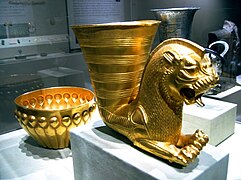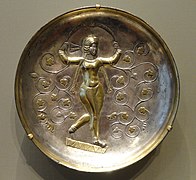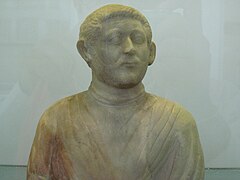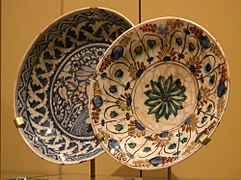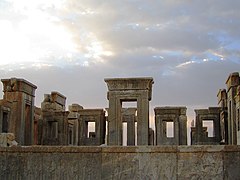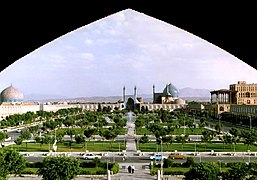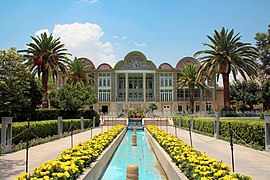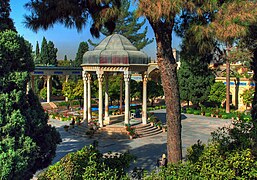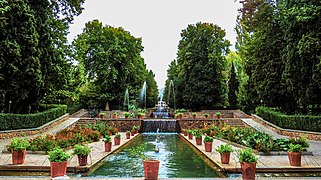페르시아인
Persiansپارسیها | |
|---|---|
| 총인구 | |
| c. 6000만 이상[1] | |
| 인구가 많은 지역 | |
| c. 55,250,000(표준)[2] | |
| 언어들 | |
| 페르시아어, 기타 이란어 | |
| 종교 | |
| 과반수: 시아파 이슬람 소수: 조로아스터교, 기독교, 바하이 신앙, 수니파 이슬람, 수피교 및 기타 여러[3][4] 종교 | |
| 관련 민족 | |
| 기타 이란인 | |
페르시아인들은 이란 [2]인구의 절반 이상을 차지하는 이란 민족 집단이다.그들은 공통의 문화 체계를 공유하고 페르시아어와 [8]밀접한 관련이 있는 언어뿐만 아니라 페르시아어를[5][6][7] 모국어로 사용하는 사람들이다.
고대 페르시아인들은 원래 기원전 [9][10]9세기까지 페르시스 지역으로 이주한 고대 이란 민족이었다.그들의 동포 동맹들과 함께, 그들은 고대 [12][13][14]세계의 영토와 인구의 대부분을 차지했던 거대한 문화적, 정치적, 사회적 영향으로 잘 알려진 세계에서 가장 강력한[11][10] 제국들을 설립하고 통치했다.역사를 통틀어, 페르시아 사람들은 예술과 [15][16][17]과학에 크게 기여했다.페르시아 문학은 세계에서 가장 유명한 문학 전통 [18]중 하나이다.
현대 용어로, 페르시아어를 모국어로 사용하는 아프가니스탄, 타지키스탄, 우즈베키스탄 사람들은 타지크족으로 알려져 있으며, 이전의 두 나라는 각각 다리와 타지키라고 알려진 그들만의 페르시아 방언들을 가지고 있다; 반면 코카서스 (주로 현재 아제르바이잔 공화국과 다게스탄, 러시아)에 있는 사람들은 타지크족으로 알려져 있다.ia)는 고도로 동화되었지만 태츠로 [19][20]알려져 있다.그러나 역사적으로 타지크어와 타트라는 용어는 페르시아어와 [19]동의어로 서로 바꿔 쓰였다.페르시아의 유력 인사들은 현재 이란의 국경 밖인 아프가니스탄과 중앙아시아 북동쪽, [21][22]북서쪽의 코카서스 산맥에서 온 사람들이다.역사적 맥락에서, 특히 영어에서, "페르시아어"는 그들의 민족적 배경과 상관없이 고대 페르시아 정치의 모든 주제를 다루기 위해 더 느슨하게 정의될 수 있다.
민족명
어원학
페르시아라는 용어는 "페르시아에서 왔다"는 뜻의 라틴 페르시아에서 [24]유래했으며, 그 자체가 현대 페르시아에서 파르스(Parrsa)로 진화한 고대 페르시아어 파르사(Parrsa)[23]의 헬레니즘화된 형태인 그리스어 페르시스에서 유래했다.성경, 특히 다니엘, 에스더, 에즈라, 네헤미아 책에서는 파라스(Pararas)로 나온다.
그리스 민속 어원은 그리스 신화의 전설적인 인물인 페르세우스와 그 이름을 연관시켰다.헤로도토스는 페르시아인들이 이름을 따온 외국인 아들 페르세스를 떠올리며 이 이야기를 [25]이야기한다.분명히, 크세르크세스 1세가 그리스 침공 중에 아르고브인들을 제압하기 위해 사용하려 했지만, 결국 그렇게 하지 못했기 때문에, 페르시아인들 스스로도 [26]그 이야기를 알고 있었다.
사용 이력
페르시스는 고대 [27]이란의 지방 중 하나였을 뿐이지만, 이 용어의 다양성(예: 페르시아)은 그리스 소스를 통해 채택되어 여러 [28]해 동안 모든 페르시아 제국의 익명으로 사용되었습니다.따라서, 특히 서구 세계에서는 페르시아와 페르시아라는 이름이 이란과 그 [28][9]신하들을 모두 지칭하게 되었다.
일부 중세 및 초기 현대 이슬람 자료들은 또한 페르시아라는 용어의 동족을 화자,[30][31] 마잔데라니,[29] 그리고 고대 아제리를 포함한 다양한 이란 사람들과 언어들을 지칭하기 위해 사용했다. 10세기 이라크의 역사학자 알-마수디는 페르시아어의 [32]방언으로 팔라비, 다리와 아자리를 언급한다.1333년, 중세 모로코의 여행자이자 학자인 이븐 바투타는 카불의 아프간인들을 [33]페르시아인들의 특정한 부계급이라고 불렀다.레이디 메리 (레오노라 울프) 쉴은, 카자르 시대에 이란을 관찰하면서, 쿠르드족과 렉족은 자신들을 "고대 페르시아인"[34]의 종족에 속한다고 생각한다고 말한다.
1935년 3월 21일 팔라비 왕조의 전 국왕 레자 샤는 국제사회에 이란이라는 고유명칭을 공식 서신에서 사용할 것을 요구하는 법령을 발표했다.그러나 페르시아라는 용어는 역사적으로 여전히 이란 [35][36]문화 대륙에 살고 있는 이란인들의 지배적인 인구를 가리키는 데 사용되고 있다.
역사
페르시아는 기원전 제3천년기의 아시리아 자료에서 수메르인들이 속한 지역을 나타내는 고대 아시리아 형태 파라셰로 처음 증명되었다.이 지역의 이름은 우르미아 호수의 서쪽과 남서쪽 지역에 이주한 유목 고대 이란 민족에 의해 채택되었고, 결국 "페르시아인"[9][37]으로 알려지게 되었다.님루드에서 발견된 살만네세르 3세의 검은 오벨리스크에 대한 기원전 9세기 신아시리아 비문은 후기의 아시리아 형태에서 파르수아와 파르수마슈를 지역으로서, 그리고 자그로스 산맥에 위치한 사람들은 페르시스와 함께 남쪽으로 이주하여 그 지역의 이름을 옮겼을 가능성이 있다.운영(예: 현대의 파르스)이며, 이는 고대 페르시아인들에게 가장 [38][39][40][41][42]이른 증거로 여겨진다.
고대 페르시아인들은 네오아시리아 [43]제국의 몰락에 큰 역할을 했다.또 다른 고대 이란 민족 집단인 메데스는 [44]기원전 612년까지 이 지역의 문화와 정치의 주요 세력이 될 미디어 중심의 제국 아래 이 지역을 통합했다.한편, 아케메네스 왕조 하에서, 페르시아인들은 중앙 중앙 중앙 권력의 속국가를 형성했다.기원전 552년, 아케메네스 페르시아인들은 중앙왕정에 대항하여 반란을 일으켰고, 기원전 550년 키루스 대왕의 왕위 계승으로 이어졌다.페르시아인들은 그들의 영향력을 이란 고원으로 간주되는 나머지 지역에 확산시켰고 엘람인과 [45]만인을 포함한 이 지역의 비이란 원주민 집단과 동화되었다.
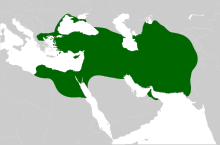
가장 큰 규모로, 아케메네스 제국은 서쪽의 동유럽 일부에서 동쪽의 인더스 계곡까지 뻗어 있었고, 세계에서 가장 [10]큰 제국이 되었다.아케메네스 왕조는 파사르가대와 페르세폴리스의 [46]도시 설립을 포함하여 그들의 영향력 증대를 지원하기 위한 기반시설을 개발하였다.제국은 현대 그리스 본토에 있는 그리스 도시 국가들의 한계까지 확장했고, 페르시아와 아테네인들은 본질적으로 상호 문화 [47]교류에 서로 영향을 끼쳤다.그리스-페르시아 [13]전쟁 이후 페르시아인들이 유럽에서 철수한 후에도 수 세기 동안 마케도니아 왕국에 대한 그것의 유산과 영향은 두드러지게 [13]컸다.
아케메네스 시대 동안 페르시아 식민지 주민들은 [48]소아시아에 정착했다.사르디스 근처에 있는 리디아에는 히르카니아 평원이 있었는데, 스트라보에 따르면 히르카니아에서 [49]이주한 페르시아 정착민들로부터 이름을 얻었다고 한다.비슷하게 사르디스 근처에는 키루스의 평원이 있었는데, 이것은 그 [50]지역에 수많은 페르시아 정착촌이 있다는 것을 더욱 의미했다.이 모든 세기 동안, 보도에 따르면 리디아와 폰투스는 [50]소아시아에서 페르시아 신들을 숭배하는 주요 중심지였다고 한다.Pausanias에 따르면, 서기 2세기까지 히로카에살리아와 히파에파 [50]마을에서의 페르시아의 불꽃놀이 의식과 비슷한 의식을 볼 수 있었다.페르시아 귀족이자 키우스 마을의 페르시아 지배 엘리트 중 일부인 키우스의 미트리다테스 3세는 그의 말년에 [51][52]소아시아 북부에 폰토스 왕국을 세웠다.미트리다테스 6세라는 악명 높은 미트리다테스 6세 치하에서 폰토스 왕국은 콜키스, 카파도키아, 비티니아, 타우리스 케르소네소스의 그리스 식민지, 그리고 잠시 동안 아시아의 로마 속주를 지배했다.미트리다이트 전쟁에서 로마와 오랜 투쟁 끝에 폰토스는 패배했다; 폰토스의 일부는 비티니아와 폰토스 속주로 로마 공화국에 통합되었고, 동쪽 절반은 종속 왕국으로 살아남았다.
마케도니아 정복 이후, 카파도키아와 소아시아의 다른 페르시아 식민지 주민들은 이란에 있는 그들의 동종교자들과는 적절히 단절되었지만,[53] 그들은 계속해서 그들의 조상들의 이란 신앙을 실천했다.기원전 1세기 카파도키아 왕국에서 이들을 관찰한 스트라보는 이 "불쏘시개"들이 많은 "페르시아 신들의 성지"와 [53]불사원을 소유하고 있다고 기록한다.아케메네스 페르시아 제국이 멸망한 지 거의 300년이 지난 r.아우구스투스 시대에 글을 쓴 스트라보는 소아시아 서부의 페르시아인들의 흔적만을 기록하고 있지만, 그는 카파도키아를 "페르시아의 거의 살아있는 부분"[54]으로 여겼다.
이란의 지배력은 기원전 330년 알렉산더 대왕의 아케메네스 제국 정복 이후 무너졌지만, 얼마 지나지 않아 파르티아에서 온 고대 이란인 집단에 의해 세워진 파르티아 제국을 통해 다시 나타났다.파르티아 시대까지 이란의 정체성은 민족적, 언어적, 종교적 가치를 가지고 있었다.하지만, 그것은 아직 정치적인 [55]의미를 지니지 않았다.파르티아 제국의 공용어로 사용된 파르티아어는 페르시아어와 [56][57][58]이웃 아르메니아어에 영향을 미쳤다.
파르티아 왕정은 서기 224년 페르시아의 사산 왕조에 의해 계승되었다.사산 제국이 되자, 이란인임을 충분히 인식한 민족 문화가 형성되었고, 부분적으로 "구현자"[55]의 지혜의 복원과 부활에 의해 동기 부여되었다.이 민족문화의 다른 측면에는 위대한 영웅적 과거와 아치형 [55]정신에 대한 미화가 있었다.이 기간 내내 이란의 정체성은 모든 [55]면에서 최고조에 달했다.현대 페르시아어와 다른 다양한 이란 [56][59][60][61]방언의 직계 조상인 중 페르시아어는[62] 제국의 공용어가 되었고 [55]이란인들 사이에서 크게 확산되었다.
파르티아인들과 사산인들은 또한 로마인들과 문화적으로 폭넓게 교류할 것이다.로마-페르시아 전쟁과 비잔틴-사산 전쟁은 수세기 동안 서아시아, 유럽, 코카서스, 북아프리카, 지중해 분지의 풍경을 형성했다.400년이 넘는 기간 동안, 사산인과 이웃의 비잔틴은 세계에서 [63][64][65]두 개의 주요 강국으로 인정받았다.지금은 로마시대로 접어든 고대 후기의 카파도키아는 여전히 중요한 이란인의 특징을 유지하고 있다; Stephen Mitchell은 옥스퍼드 후기 사전에서 "카파도키아의 많은 주민들은 페르시아 혈통이었고 이란인의 불 숭배는 465년까지 증명되었다"[66]고 언급했다.
중세 아랍이 사산 제국을 정복한 후, 아랍 칼리파들은 이후 몇 세기 동안 이란 이슬람화의 긴 과정이 일어났던 이 지역에 대한 그들의 통치를 확립했다.페르시아인들의 문화적, 언어적 지배에 맞서, 우마이야드 칼리프국을 시작으로, 아랍 정복자들은 아랍어를 그들의 제국 전체에 걸쳐, 때로는 무력에 의해, 그 [67]지역에 대한 새로운 정치적 현실을 더욱 확인시켜주면서, 아랍어를 그들의 주체들의 주요 언어로 확립하기 시작했다.아랍어 용어 "아잠"은 "제대로 말할 수 없는 사람들"을 의미하며, 비아랍어 사용자들, 특히 페르시아인들을 [68]지칭하는 말로 채택되었다.비록 이 용어는 경멸적인 의미와 문화적, 민족적 열등감을 암시했지만, 점차적으로 "페르시아인"[67][69][70]의 동의어로 받아들여졌고,[71] 오늘날에도 여전히 중동의 현대 아랍 국가에서 유래한 페르시아어를 사용하는 공동체를 지칭하는 명칭으로 남아 있다.이슬람 이란 왕국의 시리즈 후 생산이 감소한 아바스 왕조의 주변부에ninth-century Samanids의, 이 중에 페르시아어 공식적으로 language,[72]의 증거의 2세기 이후로 처음 지금은 아라비아 문자와 큰 A 받아 사용되는 등 설립되었다환급.ic [73]어휘페르시아 언어와 문화는 몽골과 터키인(일카네이트, 가즈나브인, 셀주크인, 화라즈미아인, 티무르인 포함)의 침략과 정복 이후에도 계속 퍼져 나갔고, 소아시아, 중앙아시아, 남아시아에서 페르시아 문화가 번성했다.페르시아 사회, 특히 투르코-페르시아와 인도-페르시아의 혼합.
8세기 이상 이 지역에서 외국의 지배를 받은 후, 이란의 패권은 16세기 [75]사파비드 제국의 출현에 의해 다시 확립되었다.사파비드 제국 하에서 페르시아어와 정체성에 대한 집중은 더욱 되살아났고, 제국의 정치적 진화는 다시 한번 페르시아어를 나라의 [76]주요 언어로 유지하였다.사파비드 시대와 카자르 왕조와 같은 그 이후의 현대 이란 왕조 동안, 사산 페르시아 제국 시대의 건축과 도상학적 요소들이 환생하여 현대 국가를 고대 [77]과거와 연결시켰다.아케메네스 페르시아 제국을 중심으로 한 이란 고대 제국의 유산에 대한 현대적 수용은 특히 팔라비 왕조 치하에서 발전하여 근대 민족주의적 [78]자부심의 동기가 되었다.이란의 현대 건축은 그 나라의 고전 시대, 특히 아케메네스 수도 페르세폴리스와 파사르가대에 있는 고대 유적과 사산 수도 크테시폰의 [79]세부 사항에서 영감을 받았습니다.현대 수도 시라즈와 함께 고대 페르시아 지방에 해당하는 파르스는 특히 매년 열리는 국제 시라즈 예술 축제와 페르시아 [80]제국 건국 2,500주년 기념일에 관심의 중심이 되었다.팔라비 통치자들은 이란을 현대화했고 1979년 혁명이 일어날 때까지 이란을 통치했다.
인류학
현대 이란에서는 페르시아인들이 [2]인구의 대부분을 차지한다.그들은 페르시아의 [81]공용어 역할을 하는 현대 [82]사투리의 원어민입니다.
페르시아어
페르시아어는 인도유럽어족 이란어족의 서부 그룹에 속한다.현대 페르시아어는 사산제국의 공식 종교어이자 문학적 언어인 중세 페르시아어의 연속어로 분류되며, 그 자체는 아케메네스 [60][56][59]제국의 시대에 사용되었던 고대 페르시아어의 연속이다.고대 페르시아어는 [59]원문에서 증명된 가장 오래된 인도-유럽 언어 중 하나이다.고대 페르시아어의 표본은 오늘날 이란, 아르메니아, 이집트, 이라크, 루마니아,[83][84] [85]터키에서 발견되었다.고대 페르시아어로 쓰여진 가장 오래된 문서는 이란 서부의 절벽에 새겨진 아케메네스 왕조의 통치자 다리우스 대왕 시대의 다국어 비문인 베히툰 [86]비문의 것이다.
관련 그룹
인종적 또는 언어적으로 페르시아 민족과 관련된 여러 민족 집단과 공동체가 있으며, 주로 이란에 살고 있으며, 아프가니스탄, 타지키스탄, 우즈베키스탄, 코카서스, 터키, 이라크, 페르시아만의 [87]아랍 국가에도 살고 있다.
타지크족은 타지키스탄, 아프가니스탄, 우즈베키스탄 원산의 민족으로 페르시아어를 다양한 [19]방언으로 구사한다.타지키스탄과 우즈베키스탄의 타지크족은 타지키스탄의 공용어인 타지크어를 모국어로 사용하고, 아프가니스탄의 타지크족은 아프가니스탄의 공용어인 다리어를 사용한다.
코카서스(주로 아제르바이잔 공화국과 러시아 다게스탄 공화국)에 거주하는 이란계 민족인 타트족은 [88]페르시아어와 가까운 언어(타트어)를 구사한다.타트족의 기원은 사산 [89][90][91][92][93][94][95]제국 시대에 코카서스에 정착한 이란어를 사용하는 인구로 거슬러 올라간다.
이란 서부에 거주하는 이란계 민족인 루르족은 종종 페르시아인과 [96]쿠르드족과 관련이 있다.그들은 중세 페르시아어의 [97][98][61]후예로 여겨지는 루리어의 다양한 방언을 사용합니다.
아프가니스탄에서 [99][100][101]세 번째로 큰 민족 집단을 구성하는 하자라족은 하자라기라는 [102]이름으로 다양한 페르시아어를 구사하는데, 이는 보다 정확히는 다리어 방언 [103][104]연속체의 일부이다.아프가니스탄 [105]원산의 반유목 민족인 아이맥족은 아이맥이라는 이름으로 다양한 페르시아어를 구사하는데, 아이맥스도 다리어 방언 연속체에 [81][106]속합니다.
페르시아어를 사용하는 현대 아랍권 국가는 바레인의 아잠, 이라크의 아잠,[71] 쿠웨이트의 아잠 등 일반적으로 아잠으로 불린다.
문화
주고 고대 이란의 중앙값, 아케메 네스, 파르티아, 사산 제국 전역에서 이웃 그리스 도시 국가들과 Macedon,[107][13]의 왕국에, 중세의 이슬람 후 내내부터 현대 이란과 다른 사람들 유라시아의 부분, 페르시아 문화 축하를 받고, 통합된 확대되고 있는 모든 길에 world,[108][16].[109][17][108][110]이는 주로 지정학적 상황과 한때 아케메네스 제국만큼 지배적이었던 끊임없이 변화하는 정치 영역과의 복잡한 관계 때문이다.
페르시아인들의 예술적 유산은 다양하며 동서양의 공헌을 포함하고 있다.이란의 중심적인 위치 때문에 페르시아 미술은 동서양의 전통이 융합되는 지점 역할을 해왔다.페르시아인들은 서예, 카펫 짜기, 유리 세공, 칠기, 마켓, 금속 세공, 미니어처 일러스트, 모자이크, 도자기,[15] 그리고 직물 디자인을 포함한 다양한 형태의 예술에 기여해왔다.
기원전 5세기 아케메네스 금 그릇.뉴욕 메트로폴리탄 미술관
문학.
페르시아어는 세계에서 가장 오래되고 영향력 있는 문학 [18]중 하나로 알려져 있다.기원전 6세기에서 4세기 사이의 여러 비문에 페르시아어로 쓰인 오래된 작품들이 증명되고 있고, 중세 페르시아 문학은 파르티아와 사산 시대의 비문과 서기 3세기에서 10세기 사이의 조로아스터와 마니교의 경전에 증명되어 있다.새로운 페르시아 문학은 아랍의 이란 정복 이후 번성하여 9세기부터 [111]가장 오래된 기록을 가지고 있으며, 많은 동부 [18]궁정에서 궁정 전통으로 발전하였다.페르도시의 샤나메, 루미의 작품, 오마르 카얌의 루바이야트, 니자미 간자비의 판즈간지, 하페즈의 디바인, 니샤푸르의 아타르의 새 회의, 굴라네와 부스탄의 미셀라네.현대 페르시아 문학은 아흐마드 샴루, 포루프 파로크자드, 메흐디 아크하반 세일즈, 파르빈 에테사미, 사데흐 헤다얏, 시몬 다네쉬바르 등의 작가들에 의해 형성되었다.
페르시아인들이 아랍어나 그리스어와 같은 다른 언어로 쓴 작품들도 포함될 수 있기 때문에 모든 페르시아 문학이 페르시아어로 쓰여지는 것은 아니다.동시에 페르시아어로 쓰인 모든 문학이 페르시아인이나 이란인에 의해 쓰여지는 것은 아니며, 투르크인, 백인, 인도인 작가들도 페르시아 문학을 페르시아 문화의 환경에서 사용해 왔다.
아키텍처
고대 페르시아 건축의 가장 주목할 만한 예는 페르시스에서 온 아케메니드의 작품들이다.기원전 550년경 제국의 팽창으로부터 유래한 아케메네스 건축은 키루스 대왕의 파사르가다에 있는 엄숙한 무덤에서 페르세폴리스와 나크쉬에 [112]로스탐의 건축물에 이르는 유산을 남긴 예술적 성장기에 번성했다.밤 시타델은 밤 [113]실크로드에 건설된 약 194만 평방피트(18만2 m)의 거대한 건물로 기원전 5세기 경의 건물이다.아케메네스 건축의 본질적인 특징은 메디안 건축, 아시리아 건축, 그리고 아시아 그리스 건축의 요소들이 모두 통합된 [114]그것의 절충적인 성격이었다.
사산제국의 건축 유산은 무엇보다도 데르벤트 요새(현재 러시아의 일부인 북 코카서스에 위치), 루드칸 성, 샤프르-콰스트 성, 아르다시르 궁전, 사르베스탄 궁전 등의 성곽, 샤레스트란 다리, 샤프란 다리 등을 포함한다. 브릿지, 크테시폰 아치웨이, 그리고 Taq-e Bostan의 구호물.
Taq-e Bostan에 있는 Sasanian 구호품.
이란의 고대 페르시아 제국 시대의 건축적 요소들이 후기에 [77]채택되고 통합되었다.특히 팔라비 왕조 치하의 이란 근대화 과정에서 고대 역사를 [78][79]가진 근대국가를 특징짓는 데 기여하기 위해 사용되었다.
정원
크세노폰은 Oeconomicus에서 [115]다음과 같이 말한다.
"크루스 2세 국왕은 그가 살고 방문하는 모든 지역에 땅이 만들어내는 좋고 아름다운 것들로 가득 찬 파라다이스("파라다이스")가 있는 것을 돌봅니다."
페르시아 정원은 아케메네스 제국 전체에서 발견된 최초의 사례로 페르시아 [116]건축에서 중요한 위치를 차지하고 있다.정원은 아케메네스 왕조의 [115]군주들에게 중요한 위치를 차지했고, 수도관, 최초로 기록된 중력에 의해 공급된 물줄기, 기하학적 체계로 배열된 분지를 포함한 아케메네스 왕조의 고급 물 [117]기술에 대한 지식을 활용했다.궁전과 같은 기반시설에 의해 대칭적으로 배치된 식재 및 관개 시설은 "낙원"[118]의 인상을 만들었다.파라다이스라는 단어 자체는 말 그대로 "벽이 둘러져 있다"는 의미로 번역되는 아베스탄 페리다(고대 페르시아어 파리다; 신 페르시아어 파디스, 퍼도우)에서 유래했다.사분원([115]차르박) 디자인으로 특징지어진 페르시아 정원은 역사를 통해 진화하고 발전하여 유라시아의 다양한 문화권에도 채택되었다.그것은 2011년 6월에 유네스코 세계문화유산에 등재되었다.
카펫

융단 짜기는 [119]페르시아 문화의 필수적인 부분이며, 페르시아 융단은 가장 세밀한 수작업 예술 작품 중 하나로 알려져 있다.
아케메니드 러그와 카펫의 예술성은 잘 알려져 있다.크세노폰은 사르디스 시의 카펫 생산을 묘사하면서 현지인들이 그들의 카펫 생산에 자부심을 가지고 있다고 말한다.페르시아 카펫에 대한 특별한 언급은 나우크라티스의 아테나이우스도 그의 Deipnosophistae에서 언급하고 있는데, 그는 페르시아 카펫에 "미려하게 수놓아진 그리핀 모양"[120]을 묘사하고 있다.
현존하는 카펫 중 세계에서 가장 오래된 것으로 여겨지는 기원전 4세기 스키타이 시대의 파일 카펫인 파지리크 카펫은 페르시아 [120]왕실의 건물에서 발견된 석판 디자인에 대한 양식적인 언급을 포함하여 아시리아와 아케메네스 양식의 요소를 묘사합니다.
음악

크세노폰에 의해 보고된 바에 따르면, 많은 수의 가수들이 아케메니드 궁전에 참석했다고 한다.그러나 그 시대의 음악으로부터 얻을 수 있는 정보는 거의 없다.사산 제국의 음악계는 초기 시대보다 더 많은 이용 가능하고 상세한 기록을 가지고 있으며, 특히 조로아스터교의 음악 [121]의식에서 더욱 뚜렷하다.전반적으로, 사산 음악은 영향을 미쳤고 그 [122]다음 시대에 채택되었다.
이란 음악은 전체적으로 이 지역 고유의 다양한 악기를 사용하고 있으며, 고대와 중세 이후 현저하게 발전해 왔다.전통적인 사산 음악에서 옥타브는 17개의 음조로 나뉘었다.13세기 말까지, 이란 음악은 또한 서양의 [123]그것과 비슷한 12간격 옥타브를 유지했다.
관찰 사항
이란 새해 첫날인 노루즈는 페르시아와 이란의 다른 사람들에 의해 그레고리력으로 3월 21일경에 해당하는 파르바르딘의 첫 달인 춘분일에 봄의 시작을 기념하기 위해 기념된다.누루즈는 이란과 이란의 [124][125]고대 제국의 영향을 받은 여러 나라에서 보존되어 온 고대 전통으로 유네스코의 무형문화유산에 [126]등록되었다.이란에서는 나우루즈 축제(포함).차르샨베 수리와 시즈데베다)는 이란 달력에서 전년의 마지막 수요일 전날에 시작하여 새해의 13일에 끝난다.이슬람 축제는 또한 이슬람 페르시아인들에 의해 널리 기념된다.
레퍼런스
- ^ "Persian, Iranian". Ethnologue. Retrieved 11 December 2018. 모든 국가의 이란어 사용자 합계.
- ^ a b c "Country Profile: Iran" (PDF). Library of Congress – Federal Research Division. May 2008. Retrieved 30 April 2019.
- ^ "Goman Poll".
- ^ "Goman Poll jpg".
- ^ Beck, Lois (2014). Nomads in Postrevolutionary Iran: The Qashqa'i in an Era of Change. Routledge. p. xxii. ISBN 978-1317743866.
(...) an ethnic Persian; adheres to cultural systems connected with other ethnic Persians (...)
- ^ Samadi, Habibeh; Perkins, Nick (2012). Ball, Martin; Crystal, David; Fletcher, Paul (eds.). Assessing Grammar: The Languages of Lars. Multilingual Matters. p. 169. ISBN 978-1-84769-637-3.
- ^ Fyre, R. N. (29 March 2012). "IRAN v. PEOPLES OF IRAN". Encyclopædia Iranica.
The largest group of people in present-day Iran are Persians (*q.v.) who speak dialects of the language called Fārsi in Persian, since it was primarily the tongue of the people of Fārs."
- ^ Anonby, Erik J. (20 December 2012). "LORI LANGUAGE ii. Sociolinguistic Status of Lori". Encyclopædia Iranica.
Conversely, the Nehāvand sub-province of Hamadān is home to ethnic Persians who speak NLori as a mother tongue. (...) The same is true of areas to the southwest, south, and east of the Lori language area (...): while the varieties spoken there show more structural similarity to Lori than to Persian, speakers identify themselves as ethnically Persian.
- ^ a b c Xavier de Planhol (24 January 2012). "FĀRS i. Geography". Encyclopædia Iranica. Vol. IX. pp. ?–336.
The name of Fārs is undoubtedly attested in Assyrian sources since the third millennium B.C.E. under the form Parahše. Originally, it was the "land of horses" of the Sumerians (Herzfeld, pp. 181-82, 184-86). The name was adopted by Iranian tribes which established themselves there in the 9th century B.C.E. in the west and southwest of Urmia lake. The Parsua (Pārsa) are mentioned there for the first time in 843 B.C.E., during the reign of Salmanassar III, and then, after they migrated to the southeast (Boehmer, pp. 193-97), the name was transferred, between 690 and 640, to a region previously called Anšan (q.v.) in Elamite sources (Herzfeld, pp. 169-71, 178-79, 186). From that moment the name acquired the connotation of an ethnic region, the land of the Persians, and the Persians soon thereafter founded the vast Achaemenid empire. A never-ending confusion thus set in between a narrow, limited, geographical usage of the term—Persia in the sense of the land where the aforesaid Persian tribes had shaped the core of their power—and a broader, more general usage of the term to designate the much larger area affected by the political and cultural radiance of the Achaemenids. The confusion between the two senses of the word was continuous, fueled by the Greeks who used the name Persai to designate the entire empire.
- ^ a b c Sacks, David; Murray, Oswyn; Brody, Lisa R. (2005). Encyclopedia of the Ancient Greek World. Facts On File. p. 256 (at the right portion of the page). ISBN 978-0-8160-5722-1.
- ^ Schmitt, R. "ACHAEMENID DYNASTY". Encyclopædia Iranica. Vol. I. pp. 414–426.
In 550 B.C. Cyrus (called "the Great" by the Greeks) overthrew the Median empire under Astyages and brought the Persians into domination over the Iranian peoples; he achieved combined rule over all Iran as the first real monarch of the Achaemenid dynasty. Within a few years he founded a multinational empire without precedent—a first world-empire of historical importance, since it embraced all previous civilized states of the ancient Near East. (...) The Persian empire was a multinational state under the leadership of the Persians; among these peoples the Medes, Iranian sister nation of the Persians, held a special position.
- ^ Farr, Edward (1850). History of the Persians. Robert Carter. pp. 124–7.
- ^ a b c d Roisman & Worthington 2011, 페이지 345.
- ^ Durant, Will (1950). Age of Faith. Simon and Schuster. p. 150.
Repaying its debt, Sasanian art exported its forms and motives eastward into India, Turkestan, and China, westward into Syria, Asia Minor, Constantinople, the Balkans, Egypt, and Spain.
- ^ a b Burke, Andrew; Elliot, Mark (2008). Iran. Lonely Planet. pp. 295 & 114–5 (for architecture) and pp. 68–72 (for arts). ISBN 9781742203492.
- ^ a b Hovannisian, Richard G.; Sabagh, Georges (1998). The Persian Presence in the Islamic World. Cambridge University Press. pp. 80–83. ISBN 9780521591850.
- ^ a b Spuler, Bertold; Marcinkowski, M. Ismail (2003). Persian Historiography & Geography. Pustaka Nasional Pte Ltd. ISBN 9789971774882.
- ^ a b c Arberry, Arthur John (1953). The Legacy of Persia. Oxford: Clarendon Press. p. 200. ISBN 0-19-821905-9.
- ^ a b c "TAJIK i. THE ETHNONYM: ORIGINS AND APPLICATION". Encyclopædia Iranica. 20 July 2009.
By mid-Safavid times the usage tājik for 'Persian(s) of Iran' may be considered a literary affectation, an expression of the traditional rivalry between Men of the Sword and Men of the Pen. Pietro della Valle, writing from Isfahan in 1617, cites only Pārsi and ʿAjami as autonyms for the indigenous Persians, and Tāt and raʿiat 'peasant(ry), subject(s)' as pejorative heteronyms used by the Qezelbāš (Qizilbāš) Torkmān elite. Perhaps by about 1400, reference to actual Tajiks was directed mostly at Persian-speakers in Afghanistan and Central Asia; (...)
- ^ Ostler, Nicholas (2010). The Last Lingua Franca: English Until the Return of Babel. Penguin UK. pp. 1–352. ISBN 978-0141922218.
Tat was known to have been used at different times to designate Crimean Goths, Greeks and sedentary peoples generally, but its primary reference came to be the Persians within the Turkic domains. (...) Tat is nowadays specialized to refer to special groups with Iranian languages in the west of the Caspian Sea.
- ^ Nava'i, Ali Shir (tr. & ed. Robert Devereaux) (1996). Muhakamat al-lughatain. Leiden: Brill. p. 6.
- ^ Starr, S. F. (2013). Lost Enlightenment: Central Asia's Golden Age from the Arab Conquest to Tamerlane. Princeton University Press.
- ^ 리델, 헨리 조지, 스콧, 로버트, 페르세우스 프로젝트의 그리스 영어 어휘집.
- ^ Harper, Douglas. "Persia". Online Etymology Dictionary.
- ^ Herodotus. "61". Histories. Vol. Book 7.
- ^ Herodotus. "150". Histories. Vol. Book 7.
- ^ Wilson, Arnold (2012). "The Middle Ages: Fars". The Persian Gulf (RLE Iran A). Routledge. p. 71. ISBN 978-1136841057.
- ^ a b Axworthy, Michael (2017). Iran: What Everyone Needs to Know. Oxford University Press. p. 16. ISBN 978-0190232962.
- ^ 예를 들어, 화레즈미안의 원어민인 알 비루니는 "화리즘 사람들"을 "페르시아 나무의 한 가지"라고 부른다.참조: (번역: Khwarizm 사람들은 페르시아 나무의 한 갈래입니다.)")
- ^ 마르즈반나마에 사용된 언어는 13세기 역사학자 사드 앗딘 와라위니의 말로 "아바리스탄과 고대 페르시아어 (파르시이 adadīm-i bastann)"였다.참조:
- ^ 10세기 아랍 이슬람 작가 이븐 호칼은 그의 "우라트 알-아르"에서 "아제르바이잔 사람들과 아르메니아 사람들의 언어"를 알-파레시야라고 부른다.Yarshater, E. (18 August 2011). "AZERBAIJAN vii. The Iranian Language of Azerbaijan". Encyclopædia Iranica. Vol. III. pp. 238–245.
- ^ Al Mas'udi (1894). De Goeje, M.J. (ed.). Kitab al-Tanbih wa-l-Ishraf (in Arabic). Brill. pp. 77–78.
- ^ Ibn Battuta (2004). Travels in Asia and Africa, 1325-1354. Routledge. p. 180. ISBN 0-415-34473-5.
We travelled on to Kabul, formerly a vast town, the site of which is now occupied by a village inhabited by a tribe of Persians called Afghans. They hold mountains and defiles and possess considerable strength, and are mostly highwaymen. Their principal mountain is called Kuh Sulayman. It is told that the prophet Sulayman [Solomon] ascended this mountain and having looked out over India, which was then covered with darkness, returned without entering it.
- ^ Sheil, Lady Mary Leonora Woulfe (1856). Glimpses of Life and Manners in Persia. J. Murray. p. 394.
- ^ "Persian". Merriam-Webster. 13 August 2010. Retrieved 10 June 2012.
- ^ Bausani, Alessandro (1971). The Persians, from the Earliest Days to the Twentieth Century. Elek. ISBN 978-0-236-17760-8.
- ^ Stearns, Peter N., ed. (2001). "The Medes and the Persians, c.1500-559". Encyclopedia of World History (6th ed.). The Houghton Mifflin Company.
- ^ Schmitt, R. (21 July 2011). "ACHAEMENID DYNASTY". Encyclopædia Iranica. Vol. I. pp. 414–426.
The Achaemenid clan possibly ruled over the Persian tribes already in the 9th century B.C., when they were still settled in northern Iran near Lake Urmia and tributary to the Assyrians. Of a king with the name Achaemenes there is no historical evidence; but it may have been under him that the Persians, under the pressure of Medes, Assyrians, and Urartians, migrated south into the Zagros region, where they founded, near the Elamite borders, the small state Parsumaš (with residence at present-day Masǰed-e Solaymān in the Baḵtīārī mountains, according to R. Ghirshman).
- ^ Strootman, Rolf; Versluys, M. J. (2017). Persianism in Antiquity. Franz Steiner Verlag. p. 22. ISBN 9783515113823.. (제53조).
- ^ Zarinkoob, Abdolhossein. Ruzgārān: Tārix-e Irān az Āğāz ta Soqut-e Saltanat-e Pahlavi روزگاران: تاریخ ایران از آغاز تا سقوط سلطنت پهلوی [Times: History of Iran from the Beginning to the Fall of the Pahlavi Monarchy] (in Persian). Sokhan. p. 37.
- ^ Firuzmandi, Bahman (1996). Mād, Haxāmaneši, Aškāni, Sāsāni ماد، هخامنشی، اشکانی، ساسانی [Median, Achaemenid, Arsacid, Sasanian]. Marlik. pp. 12–20, 155.
- ^ Eduljee, K.E. (2012), "Zoroastrian Heritage", Heritage Institute, retrieved 9 April 2014
- ^ Oppenheim, A. Leo (1964). Ancient Mesopotamia: Portrait of a Dead Civilization. University of Chicago Press. p. 49.
- ^ Yarshater, Ehsan (29 March 2012). "IRAN ii. IRANIAN HISTORY (1) Pre-Islamic Times". Encyclopædia Iranica. Vol. XIII. pp. 212–224.
Of the numerous Iranian tribes who had settled in Iranian plateau, it was the Medes (...) who grew in power and achieved prominence. (...) Finally in 612 B.C.E. and in alliance with the Babylonians, he attacked the Assyrian capital, Nineveh. Their combined forces succeeded in bringing the Assyrian Empire down, thus eliminating a power that had ruled with ruthless efficiency over the Middle East for several centuries. (...) Achaemenes (q.v.; Haxāmaniš), eponymous ancestor of the Achaemenids according to Darius I, formed a kingdom in the Elamite territory of Anshan in Fārs as a vassal of the Median king (...).
- ^ Xavier de Planhol (29 March 2012). "IRAN i. LANDS OF IRAN". Encyclopædia Iranica. Vol. XIII. pp. 204–212.
- ^ Gates, Charles (2003). Ancient Cities: The Archaeology of Urban Life in the Ancient Near East and Egypt, Greece and Rome. Psychology Press. p. 186. ISBN 9780415121828.
- ^ Margaret Christina Miller (2004). Athens and Persia in the Fifth Century BC: A Study in Cultural Receptivity. Cambridge University Press. p. 243. ISBN 9780521607582.
- ^ Raditsa 1983, 105페이지
- ^ Raditsa 1983, 페이지 102, 105
- ^ a b c Raditsa 1983, 페이지 102
- ^ 맥깅 1986, 페이지 15
- ^ 반담 2002, 페이지 17
- ^ a b 보이스 2001, 페이지 85
- ^ Raditsa 1983, 페이지
- ^ a b c d e Gnoli, Gherardo (30 March 2012). "IRANIAN IDENTITY ii. PRE-ISLAMIC PERIOD". Encyclopædia Iranica. Vol. XIII. pp. 504–507.
The inscriptions of Darius I (...) and Xerxes, in which the different provinces of the empire are listed, make it clear that, between the end of the 6th century and the middle of the 5th century B.C.E., the Persians were already aware of belonging to the ariya "Iranian" nation (...). Darius and Xerxes boast of belonging to a stock which they call "Iranian": they proclaim themselves "Iranian" and "of Iranian stock," ariya and ariya čiça respectively, in inscriptions in which the Iranian countries come first in a list that is arranged in a new hierarchical and ethno-geographical order, compared for instance with the list of countries in Darius's inscription at Behistun (...). All this evidence shows that the name arya "Iranian" was a collective definition, denoting peoples (...) who were aware of belonging to the one ethnic stock, speaking a common language, and having a religious tradition that centered on the cult of Ahura Mazdā. (...) Although, up until the end of the Parthian period, Iranian identity had an ethnic, linguistic, and religious value, it did not yet have a political import. The idea of an "Iranian" empire or kingdom is a purely Sasanian one. (...) It was in the Sasanian period, then, that the pre-Islamic Iranian identity reached the height of its fulfilment in every aspect: political, religious, cultural, and linguistic (with the growing diffusion of Middle Persian). Its main ingredients were the appeal to a heroic past that was identified or confused with little-known Achaemenid origins (...), and the religious tradition, for which the Avesta was the chief source.
- ^ a b c Ammon, Ulrich; Dittmar, Norbert; Mattheier, Klaus J.; Trudgill, Peter (2008). Sociolinguistics / Soziolinguistik (2 ed.). Walter de Gruyter. p. 1912. ISBN 978-3110199871.
The Pahlavi language (also known as Middle Persian) was the official language of Iran during the Sassanid dynasty (from 3rd to 7th century A. D.). Pahlavi is the direct continuation of old Persian, and was used as the written official language of the country. However, after the Moslem conquest and the collapse of the Sassanids, Arabic became the dominant language of the country and Pahlavi lost its importance, and was gradually replaced by Dari, a variety of Middle Persian, with considerable loan elements from Arabic and Parthian.
- ^ Windfuhr, G. (1989). "New West Iranian". In Schmitt, R. (ed.). Compendium Linguarum Iranicarum. Wiesbaden. pp. 251–62.
- ^ Asatrian, Garnik S. (28 November 2011). "DIMLĪ". Encyclopædia Iranica. Vol. VI. pp. 405–411.
- ^ a b c Skjærvø, Prods Oktor (29 March 2012). "IRAN vi. IRANIAN LANGUAGES AND SCRIPTS (2) Documentation". Encyclopaedia Iranica. Vol. XIII. pp. 348–366.
Only the official languages Old, Middle, and New Persian represent three stages of one and the same language, whereas close genetic relationships are difficult to establish between other Middle and Modern Iranian languages. Modern Yaḡnōbi belongs to the same dialect group as Sogdian, but is not a direct descendant; Bac-trian may be closely related to modern Yidḡa and Munji (Munjāni); and Wakhi (Wāḵi) belongs with Khotanese. (...) New Persian, the descendant of Middle Persian and official language of Iranian states for centuries, is today spoken widely in and outside Iran in a number of variants.
- ^ a b Lazard, Gilbert (1975). "The Rise of the New Persian Language". In Frye, R. N. (ed.). The Cambridge History of Iran. Vol. 4. Cambridge: Cambridge University Press. pp. 595–632.
The language known as New Persian, which was usually called at this period by the name of darī or parsī-i darī, can be classified linguistically as a continuation of Middle Persian, the official, religious and literary language of Sasanian Iran, itself a continuation of Old Persian, the language of the Achaemenids. Unlike the other languages and dialects, ancient and modern, of the Iranian group such as Avestan, Parthian, Soghdian, Kurdish, Pashto, etc., Old Middle and New Persian represent one and the same language at three states of its history. It had its origin in Fārs (the true Persian country from the historical point of view) and is differentiated by dialectical features, still easily recognizable from the dialects prevailing in north-western and eastern Iran.
- ^ a b Coon, C.S. "Demography and Ethnography". Iran. Encyclopaedia of Islam. Vol. IV. E.J. Brill. pp. 10–8.
The Lurs speak an aberrant form of Archaic Persian (...)
- ^ Fortson, Benjamin W. (2009). Indo-European Language and Culture: An Introduction. John Wiley and Sons. p. 242.
Middle Persian was the official language of the Sassanian dynasty (...)
- ^ (Shapur Shahbazi 2005) 오류:: 2005
- ^ Stillman, Norman A. (1979). The Jews of Arab Lands. Jewish Publication Society. p. 22. ISBN 0827611552.
- ^ International Congress of Byzantine Studies (30 September 2006). Proceedings of the 21st International Congress of Byzantine Studies, London, 21-26 August 2006. Vol. 1–3. Ashgate Publishing. p. 29. ISBN 075465740X.
- ^ 미첼 2018, 페이지 290
- ^ a b Frye, Richard Nelson; Zarrinkoub, Abdolhosein (1975). Cambridge History of Iran. Vol. 4. London. p. 46.
- ^ "ʿAJAM". Encyclopædia Iranica. Vol. I. 29 July 2011. pp. 700–701.
- ^ Esposito, John L. (21 October 2004). The Oxford Dictionary of Islam. Oxford University Press. p. 12. ISBN 9780199757268.
People unable to speak properly. Refers to non-Arabs. Connotes cultural and ethnic inferiority. Adjectival form: ajami. Principally used to designate (and eventually synonymous with) Persians.
- ^ Ngom, Fallou; Zito, Alex (2012). "Sub-Saharan African literature, ʿAjamī". In Fleet, Kate; Krämer, Gudrun; Matringe, Denis; Nawas, John; Rowson, Everett (eds.). Encyclopaedia of Islam, THREE. doi:10.1163/1573-3912_ei3_COM_26630.
- ^ a b Ende, Werner; Steinbach, Udo (2010). Islam in the World Today: A Handbook of Politics, Religion, Culture, and Society. Cornell University Press. p. 533. ISBN 9780801464898.
- ^ Paul, Ludwig (19 November 2013). "PERSIAN LANGUAGE i. Early New Persian". Encyclopædia Iranica.
- ^ Perry, John R. (10 August 2011). "ARABIC LANGUAGE v. Arabic Elements in Persian". Encyclopædia Iranica. Vol. II. pp. 229–243.
- ^ Masters, Bruce (2009). "Baghdad". In Ágoston, Gábor; Masters, Bruce (eds.). Encyclopedia of the Ottoman Empire. New York: Facts On File. p. 71. ISBN 978-0-8160-6259-1. LCCN 2008020716. Archived from the original on 16 May 2016. Retrieved 21 June 2022.
- ^ Savory, R.M. (1980). Iran under the Safavids. Cambridge: Cambridge University Press. p. 3.
Why is there such confusion about the origins of this important dynasty, which reasserted Iranian identity and established an independent Iranian state after eight and a half centuries of rule by foreign dynasties?
- ^ Matthee, Rudi (28 July 2008). "SAFAVID DYNASTY". Encyclopædia Iranica.
- ^ a b Hillenbrand, R. (11 August 2011). "ARCHITECTURE vi. Safavid to Qajar Periods". Encyclopædia Iranica. Vol. II. pp. 345–349.
Safavid inscriptions on the pre Islamic monuments (e.g., Persepolis and Bīsotūn) perhaps presage that wholesale adoption of and identification with ancient Iran that later characterized the Qajars, but there are not enough inscriptions to clinch the point. (...) An unexpected burst of activity in secular architecture marks the 17th century. Bridges which have wider functions than carrying traffic were built, reviving Sasanian custom (...). (...) Qajar decoration is usually unmistakable. Simple, rather strident tiled geometric or epigraphic designs in small glazed bricks were especially popular. The repertory of cuerda seca tiles now included episodes from the epic and legendary past, portraits of Europeans, scenes from modern life, and the country’s heraldic blazon of the lion and the sun (...). Pavilions and palaces bore figural paintings which revived Sasanian royal iconography (Negārestān palace, Tehran) or betrayed the influence of European illustrated magazines or painted postcards depicting landscapes and tourist spots (...).
- ^ a b Amanat, Abbas (22 March 2012). "HISTORIOGRAPHY ix. PAHLAVI PERIOD (1)". Encyclopædia Iranica. Vol. XII. pp. 377–386.
Typical of comparable nationalist historiographies in the early part of the 20th century (e.g., Greek, Italian, Egyptian, and Turkish), the state-sponsored historical narrative under the Pahlavis decidedly favored highlighting the might and glory of the ancient Persian empires, as supported by new archeological and textual evidences. (...) Moreover, promotion of the ancient past as a wholesale propaganda tool in the service of the state engendered nationalistic pride that proved detrimental to dispassionate historical inquiry. (...) The most visible change in the nationalist historiography under Reżā Shah was emphasis on the pre-Islamic, and particularly the Achaemenid, past.
- ^ a b Wilber, D. N. (11 August 2011). "ARCHITECTURE vii. Pahlavi, before World War II". Encyclopædia Iranica. Vol. II. pp. 349–351.
- ^ Ashraf, Ahmad (24 January 2012). "FĀRS iv. History in the Qajar and Pahlavi Periods". Encyclopædia Iranica. Vol. IX. pp. 341–351.
- ^ a b "Subfamily: Farsic". Glottolog. Retrieved 1 May 2019.
- ^ "Iran". University of Cambridge. Archived from the original on 18 September 2012. Retrieved 16 July 2013.
- ^ Kuhrt 2013, 197. 오류:: 2013
- ^ Schmitt 2000, 페이지 53. 오류:: 2000
- ^ Kent, R. G. (1950). Old Persian: Grammar Texts Lexicon. American Oriental Society. p. 6.
- ^ (Schmitt 2008, 페이지 80–1) 오류:: (도움말
- ^ "SociolinguistEssex X – 2005" (PDF). Essex University. 2005. p. 10. Archived from the original (PDF) on 14 October 2013. Retrieved 29 September 2013.
- ^ Gruenberg, Alexander (1966). "Tatskij jazyk". In Vinogradov, V. V. (ed.). Jazyki narodov SSSR. Vol. 1: Indoevropejskie jazyki. pp. 281–301.
The Tat language belongs to the Southwest group of Iranian languages and is close in its grammatical structure and lexical content to the Persian and Tajik languages.
- ^ Khanam, R., ed. (2005). Encyclopaedic Ethnography of Middle-East and Central Asia. Vol. 1: P-Z. Global Vision Publishing House. p. 746.
The contemporary Tats are the descendants of an Iranian-speaking population sent out of Persia by the dynasty of the Sasanids in the fifth to sixth centuries.
- ^ Windfuhr, Gernot (1979). Persian Grammar: history and state of its study. Walter de Gruyter. p. 4.
(...) Tat- Persian spoken in the East Caucasus (...)
- ^ Dalby, Andrew (2014). Dictionary of Languages: The Definitive Reference to More Than 400 Languages. Bloomsbury Publishing. p. 109. ISBN 978-1408102145.
(...) and Tat (a variety of Persian) (...)
- ^ Windfuhr, Genot (2013). Iranian Languages. Routledge. p. 417. ISBN 978-1135797041.
The Northwestern outpost of Persian is Caucasian Tat Persian (...)
- ^ V. Minorsky, M의 "Tat"Houtsma et al., ed.이슬람 백과: 무함마드 민족 지리학, 민족학, 전기 사전, 4권 및 부록, 레이든: 후기 E.J. 브릴과 런던: 루작, 1913–38."대부분의 페르시아 방언처럼 타티어의 특징도 규칙적이지 않습니다."
- ^ Kerslake, C. (January 2010). "Journal of Islamic Studies". 21 (1). Oxford University Press (published 4 March 2010): 147–151.
It is a comparison of the verbal systems of three varieties of Persian—standard Persian, Tat, and Tajik (...)
{{cite journal}}:Cite 저널 요구 사항journal=(도움말) - ^ Borjian, Habib (2006). "Tabari Language Materials from Il'ya Berezin's Recherches sur les dialectes persans". Iran and the Caucasus. Brill. 10 (2): 243–258. doi:10.1163/157338406780346005.
It embraces Gilani, Ta- lysh, Tabari, Kurdish, Gabri, and the Tati Persian of the Caucasus, all but the last belonging to the north-western group of Iranian language.
- ^ Frye, Richard N. (1983). Handbuch der Altertumswissenschaft, Part 3, Volume 7. Beck. p. 29. ISBN 978-3406093975.
- ^ Stilo, Donald (5 April 2012). "Isfahan xxi. PROVINCIAL DIALECTS". Encyclopædia Iranica. Vol. XIV. pp. 93–112.
- ^ Coon, C.S. "Iran: Demography and Ethnography". Encyclopedia Of Islam. Vol. IV. E.J. Brill. pp. 8–10.
- ^ "Afghanistan — The World Factbook". Central Intelligence Agency. Retrieved 17 July 2015.
- ^ Hyder, Kamal (12 November 2011). "Hazara community finds safe haven in Peshawar". Al Jazeera English. Retrieved 13 November 2011.
- ^ "Country Profile: Afghanistan" (PDF). Library of Congress. August 2008. Retrieved 5 May 2019.
- ^ Kieffer, Charles M. (20 March 2012). "HAZĀRA iv. Hazāragi dialect". Encyclopædia Iranica. Vol. XII. pp. 90–93. Retrieved 5 June 2014.
- ^ Schurmann, Franz (1962). The Mongols of Afghanistan: An Ethnography of the Moghôls and Related Peoples of Afghanistan. The Hague, Netherlands: Mouton. p. 17. OCLC 401634.
- ^ Jamal, Abedin (2010). Attitudes Toward Hazaragi. Theses. p. 217. Retrieved 5 May 2019.
- ^ Janata, A. "AYMĀQ". In Yarshater, Ehsan (ed.). Encyclopædia Iranica (Online ed.). United States: Columbia University.
- ^ "Aimaq". World Culture Encyclopedia. everyculture.com. Retrieved 14 August 2009.
- ^ Grote, George (1899). Greece: I. Legendary Greece: II. Grecian history to the reign of Peisistratus at Athens. Vol. 12. P. F. Collier. p. 106.
- ^ a b Lapidus, Ira Marvin (2002). A History of Islamic Societies. Cambridge University Press. p. 127. ISBN 9780521779333.
- ^ Sagar, Krishna Chandra (1992). Foreign Influence on Ancient India. Northern Book Centre. p. 17. ISBN 9788172110284.
- ^ Miller, Margaret Christina (2004). Athens and Persia in the Fifth Century BC: A Study in Cultural Receptivity. Cambridge University Press. pp. 243–251. ISBN 9780521607582.
- ^ Skjærvø, Prods Oktor. "Iran vi. Iranian languages and scripts (2) Documentation". Encyclopædia Iranica. Vol. XIII. pp. 348–366. Retrieved 30 December 2012.
- ^ Marco Bussagli (2005). Understanding Architecture. I.B.Tauris. p. 211. ISBN 9781845110895.
- ^ Rafie Hamidpour D E Dabfe, Rafie Hamidpour (2010). Land of Lion, Land of Sun. AuthorHouse. p. 54. ISBN 9781449091491.
- ^ Charles Henry Caffin (1917). How to study architecture. Dodd, Mead and Company. p. 80.
Persian Architecture.
- ^ a b c Penelope Hobhouse; Erica Hunningher; Jerry Harpur (2004). Gardens of Persia. Kales Press. pp. 7–13. ISBN 9780967007663.
- ^ Fakour, Mehrdad. "GARDEN i. ACHAEMENID PERIOD". Encyclopædia Iranica. Vol. X. pp. 297–298. Retrieved 30 December 2012.
- ^ L. Mays (2010). Ancient Water Technologies. Springer. pp. 95–100. ISBN 9789048186327.
- ^ Mehdi Khansari; M. Reza Moghtader; Minouch Yavari (2004). Persian Garden: Echoes Of Paradise. Mage Publishers. ISBN 9780934211758.
- ^ Mary Beach Langton (1904). How to know oriental rugs, a handbook. D. Appleton and Company. pp. 57–59.
Persian rugs.
- ^ a b Ronald W. Ferrier (1989). The Arts of Persia. Yale University Press. pp. 118–120. ISBN 0300039875.
- ^ (Lawergren 2009) 없음: 도움말) iv.첫 번째 밀레니엄 C.E. (1) 사산 음악, 224-651.
- ^ Seyyed Hossein Nasr (1987). Islamic art and spirituality. SUNY Press. pp. 3–4. ISBN 9780887061745.
- ^ Janet M. Green; Josephine Thrall (1908). The American history and encyclopedia of music. I. Squire. pp. 55–58.
music of persia.
- ^ Shahbazi, A. Shapur (15 November 2009). "NOWRUZ ii. In the Islamic Period". Encyclopædia Iranica (online ed.).
- ^ "General Assembly Recognizes 21 March as International Day of Nowruz, Also Changes to 23–24 March Dialogue on Financing for Development - Meetings Coverage and Press Releases". UN. Retrieved 20 March 2017.
- ^ UNCESCO (2009). "Intangible Heritage List". Retrieved 9 March 2011.
원천
- Ansari, Ali M. (2014). Iran: A Very Short Introduction. Oxford University Press. ISBN 978-0199669349.
- Boyce, Mary (2001). Zoroastrians: Their Religious Beliefs and Practices. Psychology Press. ISBN 978-0415239028.
- McGing, B.C. (1986). The Foreign Policy of Mithridates VI Eupator, King of Pontus. BRILL. ISBN 978-9004075917.
- Mitchell, Stephen (2018). "Cappadocia". In Nicholson, Oliver (ed.). The Oxford Dictionary of Late Antiquity. Oxford University Press. ISBN 978-0192562463.
- Raditsa, Leo (1983). "Iranians in Asia Minor". In Yarshater, Ehsan (ed.). The Cambridge History of Iran, Vol. 3 (1): The Seleucid, Parthian and Sasanian periods. Cambridge University Press. ISBN 978-1139054942.
- Roisman, Joseph; Worthington, Ian (2010). A Companion to Ancient Macedonia. John Wiley and Sons. ISBN 978-1-4051-7936-2.
- Roisman, Joseph; Worthington, Ian (2011). A Companion to Ancient Macedonia. John Wiley and Sons. ISBN 978-1-4443-5163-7.
- Van Dam, Raymond (2002). Kingdom of Snow: Roman Rule and Greek Culture in Cappadocia. University of Pennsylvania Press. ISBN 978-0812236811.
외부 링크
- "Persian, Iranian". Ethnologue.





